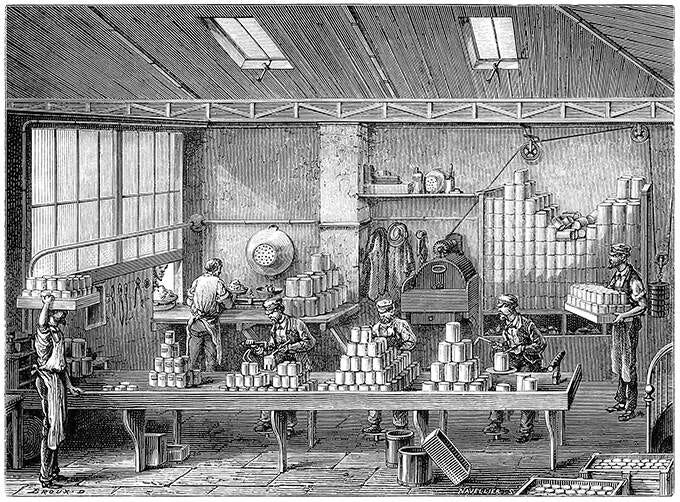Groceries 102
Buying food
Last week I hit the first of (probably) several…speed bumps? It was a place in the book where I had loosely outlined what I wanted to write about, but it was nowhere near coherent and probably happened sometime in the middle of the night after several whiskeys. I spent a solid hour staring at it, trying to decide how to move forward, then gave up and went to bed. Which brings us to this week, and after briefly glancing at it again I decided to skip it. Flat out skip the whole section. I’ll loop back to it eventually, it was probably a better outline for a one-off post than a continuation of what I’ve been writing about, so best to chip away at it over time and push it out there when it feels done.
I’ve also decided, perhaps counterintuitively since I can’t seem to push these posts out weekly, to publish them as I have time, which will likely mean I publish them more frequently, but they’ll be shorter, and will hit your inboxes when you least expect it (let the record show that I am extremely aware that this is NOT how to run a newsletter or any editorial endeavor).
I find myself experiencing what I assume many people who are wired the way I am often experience in that I have too many fun little side projects. I am a serial project starter, and lack the basic stick-to-itiveness to complete most projects. No joke, a few hours ago my wife said “Your mid-project mode is my least favorite mode”. I did not ask how many modes I had, but I am curious to see the list and know which of them is my most popular mode, at least in the eyes of my most favorite audience of one.
I assume when I was growing up normal people didn’t talk about nutrition nearly as much as they do now. Or if they did, they were hilariously wrong and the best practices did not stand the test of time or further research, and were just as fad-happy and meaningless as most of the talk about nutrition is today. I assume the goal was (and is) to be able to afford enough food to feed your family, and most people have an idea of what food they should be eating in order to stay healthy. I would wager there is a loose understanding of eating for health, but there isn’t a high awareness of why certain foods are healthier than others.
I think my mom was mainly concerned with getting dinner on the table somewhat close to ‘normal’ dinner time and making sure that all of us were full. Her assumptions were probably–I really should just ask her– vegetables are good, meat is good, every meal needs bread, and potatoes are extra good. I agree with all of these things and currently structure our family meals in a similar way.
The most widely-known and widely-distributed information about nutrition is likely the iconic USDA Food Pyramid, which was a work of art as far as marketing is concerned, but was also misleading and terribly unscientific. It was basically a depiction of which special interest groups and lobbyists in our country had the most influence on government policies. Later it was replaced by the strikingly irrelevant and poorly executed MyPyramid that communicated virtually nothing unless you went to their website. After abandoning it we got MyPlate, which was initially based on good research done by actual scientists but got obliviated by those same special interest groups and lobbyists mentioned earlier. And now it’s just another confusing, silly attempt at helping Americans feed themselves better.
All that to say, the confusion around how to feed ourselves has only increased over time as we’ve gotten more and more unfamiliar with what food is good for us, and more importantly, where food even comes from. Most people don’t know (and probably don’t care) how food gets produced and transported to our grocery stores. When you walk into a grocery store, you’re probably wandering around looking at prices and packaging and not thinking very hard about what you’re buying. I’d like to change that.
I want to discuss some of the most basic principles and guidelines that should be enough to make you feel informed. I won’t be quoting a bunch of stats or numbers at you; feel free to question my credibility because of it. If you research more because you think I’m wrong then I think that’s a win. Or maybe think I’m just cranky, which is mostly true but also not a good enough reason for you to entirely discredit what I’m saying. If I’m completely wrong about any of this and you want to buy me a beer and tell me all about it, I’ll happily take you up on it. My mind is easily changed under the influence of logic and alcohol.
First, let’s talk about food sourcing. You most likely shop at a grocery store, or you’re shopping on your phone from your couch and a creepy flying Amazon robot is bringing your groceries to your doorstep. Either way, most of you aren’t driving out to farms to select your produce or help butcher your meat, so it’s safe to say you’re far removed from the actual processes that bring food from the farm to your table (I felt I should write the words “farm” and “table” close together for SEO).

Produce
The ‘fresh’ produce you’re buying at Kroger is not usually very fresh at all. Most of it was harvested way before it was ripe or ready, and a lot of it has been altered to grow in a way that helps it last longer on the shelf (or in a woven basket if you have a fancy Kroger) and that keeps it from exploding during the transportation process. Take tomatoes as an example. Supermarket tomatoes, especially the ones labeled “Slicing Tomatoes” are so firm and dense that they’re barely tomatoes at all. That’s because they’ve been bred for those characteristics to withstand the rough and tumble transportation process. Which is fine, that’s smart, but the problem is that a lot of us have lost the taste of actual fresh tomatoes because of it. You may even think you don’t like tomatoes. But I dare you to go to a farmers market (I bet you have one in your city) and try a real fresh tomato, in season, and tell me you still don’t like them. The reason I mention tomatoes in terms of shopping is that the point of cooking for yourself is to eat more nutritious food that tastes just as good as what you get at your favorite restaurant. That is going to be a hell of a lot harder to do if you are buying a tomato that is subpar to the tomato that your favorite restaurant is buying, and even harder if you don’t know how to pick the best one. We’ve been conditioned to think that all vegetables should be extremely crisp, with no blemishes, and bonus points if they’re already prepped or washed ahead of time. The flavors, and at times the nutritional value, of those vegetables is often vastly diminished by the processes required to get it from the source to the store. So understanding what to look for in terms of appearance and flavor, while keeping in mind the caveats associated with growing and transporting produce at scale, is important. That may sound difficult or intimidating, but the good news is that it only takes a small amount of extra effort and a little trial and error before you’ll be a produce picking pro.
Try to buy fruits and vegetables in raw, unprepared form. That’s not because I’m a puritanical hippie (<- not a thing) that hates convenience and science, it’s because fresh tastes better and fresh is more fun. It’s more fun to prepare food from scratch because you become familiar with your food appreciate it more.
The first time I bought a pomegranate, I had no idea what part of it I was supposed to eat. I ended up attempting to juice the whole thing, and it was absolutely terrible. My entire mouth puckered up so violently that I thought I’d poisoned myself. Similarly, the first time I bought fennel I had to use the Internet to determine (A) what does fennel look like? and (2) which parts of it am I supposed to use? In case you’re interested, fennel looks like hairy celery and you prepare it by throwing away 75% of it and slicing up a tiny bit of the bottom. And it smells like black jelly beans.
Here, a numbered list:
- Buy fruits and vegetables that are in season. If you don’t know what’s in season, you can find that out using the Internet. If you live somewhere that doesn’t have seasons this will be a little more difficult. But worth a try.
- Shop at a farmers market for produce whenever possible. This helps with point numero uno because those farmers are only growing things that are suitable for that particular season.
- Buy organic when possible. Not because GMO or non-organic is necessarily bad (we’ll talk about why later), but because organic theoretically means no harmful pesticides or chemicals were used on that food.
- Pick things up and inspect. (Update: COVID Karens will glare at you…ignore them) Look for signs that indicate the produce may be on its way out, or isn’t ripe, or is over-ripe. Those signs vary on a per item basis, but with a little practice you’ll get better. Examples: avocados that are a little squishy are ready to eat today, while very firm or hard avocados are underripe and need time before you spread them on toast or whatever. Such an odd trend. ANYWAY. For tomatoes, you want the softer one. For bananas, get them while they’re still a little green. By the time you get around to eating one, you’ll already notice them yellowing. For kale, pick up the kale and inspect the leaves. If you’re pretty sure it’s still kale, put it back down and walk away. Kale is stupid and tastes bad.
- Exception to the “buy raw” advice: buying lettuce and other greens like spinach that are pre-washed and/or separated is a real time-saver. I’m sure someone is going to call me out for that, but I exclusively buy big tubs of pre-washed greens these days. It just takes forever to wash them and then you have to figure out how to dry them so that they don’t dissolve into mush after a couple of days (which I never figured out how to do).
That’s it for now, needed to hit pause before I dive into THE MEATS.
This week, I cooked five ribeyes by reverse-searing them and finishing them in my cast iron. I think that’s the most I’ve attempted to cook that way, but they turned out fine. If you haven’t tried the reverse-sear yet, it’s a real wonder and works great if you’re cooking for one or two.
A friend asked me for some tips on rice prep, and it reminded me of this recipe that I’ve cooked dozens of times. If you haven’t tried toasting plain ol’ white rice before cooking, it makes a huge difference.
Lastly, do any of you still use Pinterest for recipes? I thought the rice recipe I mentioned was there, but I guess I’ve neglected to keep my recipe board updated. There’s still some good ones on that board though, check it out if you want.
